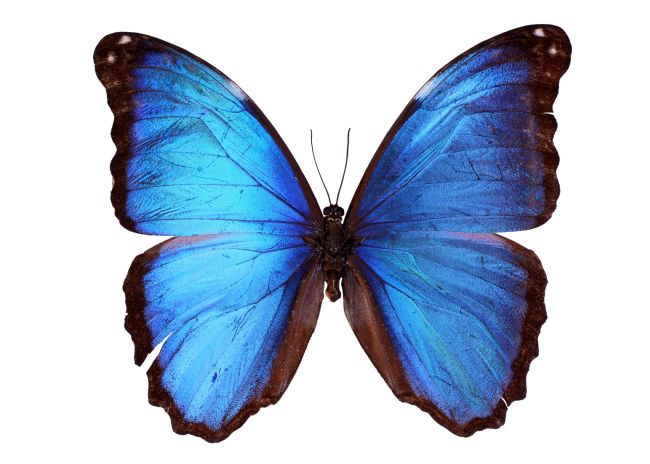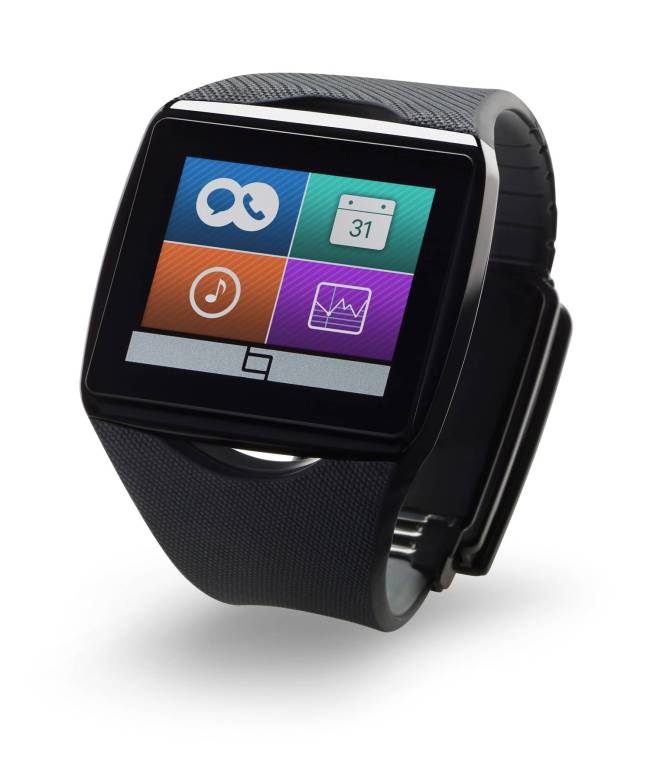
The Menelaus Blue Morpho. (123rf)
The Menelaus Blue Morpho is a curious creature. A butterfly of Central and South America, its wings have no pigment, but they shine in a brilliant, iridescent blue.
This is because the surface structure of the wings gives them their color, which changes when viewed from different angles.
“This natural process, which is called structural color, is caused by diffraction, interference and scattering of light on the surface structure,” said Hwang Kyung-hyun, a researcher at the Korea Institute of Machinery & Materials.
Opals, peacock feathers, tulip petals and rainbows are other examples of this. Structural color has attracted attention from product developers, as it does not require the use of harmful chemicals.
Iridigm Display Corporation, which was bought by U.S. tech giant Qualcomm in 2004, developed a display technology called Mirasol in the 1980s by copying the surface structure on the wings of the Menelaus Blue Morpho.
“The display has the benefits of being more power-efficient than other display panels as it is a reflective display,” said Jin Jang, a professor in the Information Department at Kyung Hee University.

Qualcomm’s Toq smart watch uses Mirasol display technology. (Qualcomm)
Qualcomm first mass-produced Mirasol displays through Korea’s Kyobo bookstore eReader in 2011. Because of its efficiency, users did not need to charge the device as frequently as rival devices.
Ahn Jung-hyun, head of Kyobo bookstore’s Digital Content Team, said the eReader could be used for more than 10 hours without charging.
Qualcomm used the Mirasol display for its smart watch, the Toq, in December 2013. As the Mirasol display does not use pigment or ink, its color and light do not change even after extended use.
“Unlike conventional smart watches, which are more focused on smart functions such as text messages or email alarms, Qualcomm Toq paid attention to the original function of watches ― checking the time,” said Qualcomm Korea’s senior director Kim Seung-soo.
“While it is difficult for a liquid crystal display to show the time under direct sunlight or at night, the visibility of the Mirasol display is much higher.”
The natural features of other creatures can also be applied to industry, Hwang said.
For instance, chameleons and grasshoppers change color by moving their pigment cells. When more materials are developed to actively control the cells, they can also be used in areas such as display technology, laser reflectors and optical components.
On reflection
The eye structure of a moth can be applied to develop antireflective films.
As moths tend to be nocturnal, they have antireflective eyes to help them hide from predators.
In the 1960s, scientists first discovered that moths’ eyes absorbed most visible light. Two decades later, they found that this was due to an antireflective nanostructure.
“When the moth’s eyes’ refractive index changes, its specular surface also decreases, suppressing light reflection,” the researcher Hwang said.
Germany’s Holotools GMBH, a microstructure technology solutions provider, developed antireflective film by copying a moth’s eye structure for use with electronic displays.
Later, Japanese printing company Toppan also developed antireflective films based on the same concept to solve problems with dazzle on liquid crystal display.
The Korea Institute of Machinery and Materials developed its own antireflection process technology based on the idea last month as part of a government green energy project.
One big advantage of the antireflective feature is that it does not require chemical lamination.
“For instance, when you use a computer or laptop, you are not able to see the screen from narrow angles because of reflection. However, when you apply this nanostructure to displays or glass surfaces, you can see clearly from any angle,” said Lim Hyung-eu, a researcher at the Korea Institute of Machinery & Materials.
“When using this nanostructure, you do not need to laminate the film or glass to stop reflections. Thus, it makes processing simpler and less expensive,” she said.
This development is a good sign for Korean display companies, which have long had to fork out large sums to use Japanese firms’ antireflection technology. There were previous attempts to develop displays using nanostructures, but Korean researchers have had difficulty getting technical advice on nanostructures that control antireflection.
When the technologies are commercialized, they could be used in solar power, electronic displays, lenses and optical films, Lim said.
The research was published in ACS Applied Materials & Interfaces. However, applying nature’s ideas to actual products is not always easy.
“When a good idea comes out from nature, it may not be difficult to verify its feasibility. However, mass production is a different story. Instead of pushing mass production prematurely, industries should take time to train personnel and develop best practices little by little,” said Song Kyung-mo, head of the Pouvoir economic institute.
By Shin Ji-hye (shinjh@heraldcorp.com)







